South America is the fourth largest continent in area. Only Asia, Africa, and North America are larger. It ranks fifth among the continents in population. Asia, Africa, Europe, and North America all have more people. South America covers about 12 percent of the world’s land area and has about 6 percent of the total world population. The continent is divided into 12 independent countries and 2 other political units.
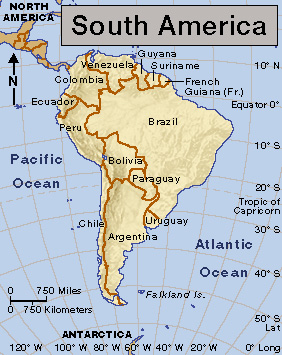
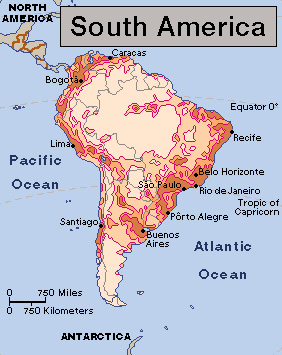
South America has nearly every type of landscape and climate. The world’s largest tropical rain forest grows in the Amazon River Basin, which occupies about two-fifths of the continent and contains an estimated 50 percent of Earth’s plant and animal species. The Atacama Desert in northern Chile is one of the driest places on Earth. Snowy peaks and active volcanoes rise along the crest of the lofty Andes Mountains of western South America. In Argentina, Uruguay, and Venezuela, rolling grasslands stretch as far as the eye can see. South America’s varied landscape also includes spectacular waterfalls, huge lakes, and rocky, windswept islands.
The continent has abundant natural resources, including rich farmlands, vast timberlands, and some of the largest deposits of valuable minerals in the world. Many South American countries, however, have not taken full advantage of their natural riches.
The countries of South America vary in their level of economic development. Most of them rely on exports of minerals and agricultural products to provide income. They must import many manufactured goods, including machinery, chemicals, and fuels. Brazil is the continent’s industrial giant. It produces and exports airplanes, motor vehicles, motor-vehicle parts, and other goods.
About 85 percent of South America’s people live in urban areas. South America’s urban population has soared since the mid-1900’s. This tremendous growth has occurred as millions of poor rural people have left farms and villages in search of better economic opportunities in the cities.
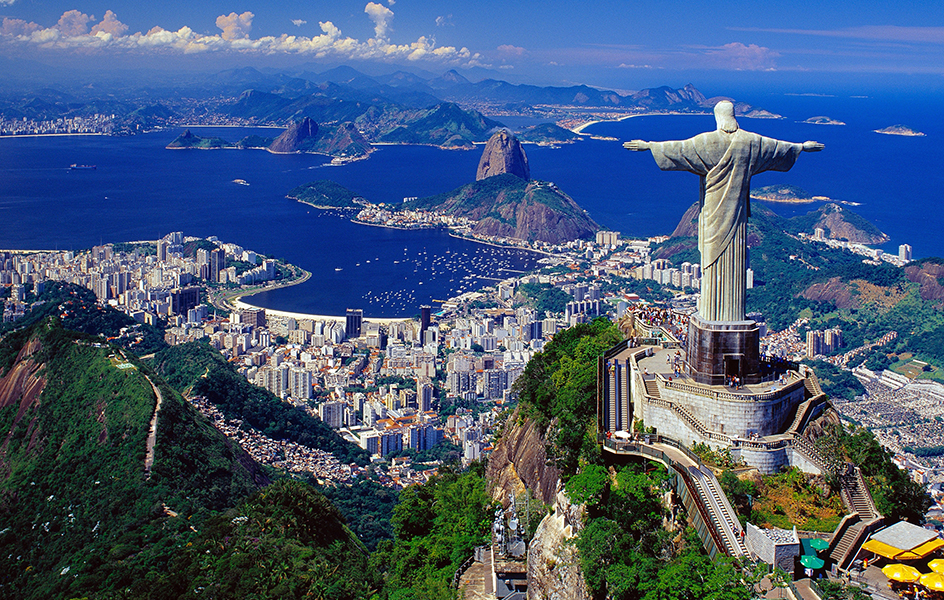
The standard of living in South America varies greatly. It is much higher in predominantly middle-class countries, such as Argentina and Uruguay, than in Bolivia, where most of the people struggle to earn a living. All South American countries have a small class of wealthy landowners, factory owners, and political and military leaders. But the vast majority of the people are poor. Since the mid-1900’s, the gap between rich and poor has widened. But there is a growing middle class in the large cities. It consists of professional people, business people, government employees, and skilled workers.
South America is part of Latin America, a large cultural region that also includes Central America, Mexico, and islands in the Caribbean Sea. This article discusses South America’s land, climate, animal and plant life, and economy. For discussions of the people, way of life, arts, and history of South America and the rest of Latin America, see Latin America and the articles on each of the independent countries and dependencies in South America.
The land
South America covers about 6,874,000 square miles (17,805,000 square kilometers)—about one-eighth of the world’s land area. The northern three-fourths of the continent lies in the tropics. The equator crosses South America about 400 miles (640 kilometers) north of the continent’s widest point. Cape Horn, the southernmost tip of South America, lies only about 600 miles (970 kilometers) from Antarctica.
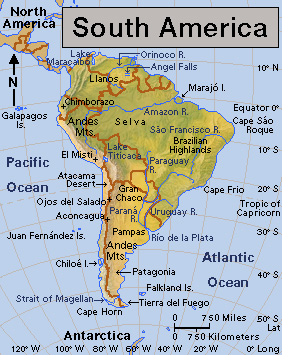
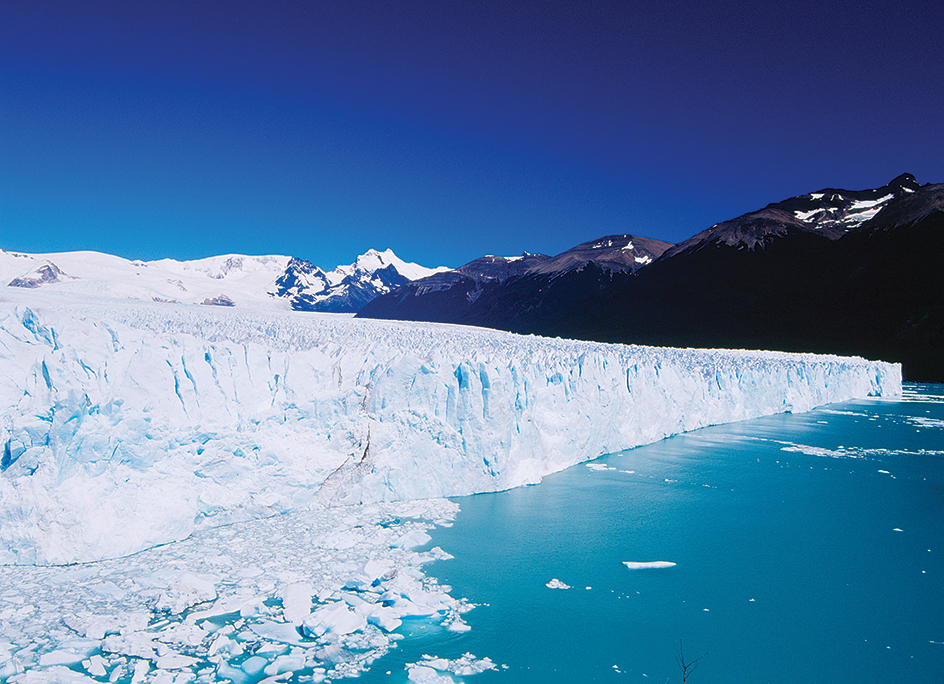
South America is almost totally surrounded by water. The Caribbean Sea lies to the north. The Atlantic Ocean borders South America on the northeast and east. To the south, the Drake Passage separates South America from Antarctica. The Pacific Ocean washes up against the continent’s west coast. South America borders land only at the Isthmus of Panama. This narrow strip of land links Central America with Colombia, in the northwestern part of South America.
Land regions.
The land surface of South America broadly resembles that of North America. Both continents have high, rugged mountain ranges in the west, vast central plains drained by mighty rivers, and older, less rugged mountains in the east. South America has three major land regions: (1) the Andes Mountains, (2) the Central Plains, and (3) the Eastern Highlands.
The Andes Mountains
form a region of jagged, snow-covered peaks; broad, grassy plateaus; steep slopes; and glacier-filled valleys. The Andes stretch for about 4,500 miles (7,200 kilometers), from Venezuela in the north to Tierra del Fuego in the south. The Andes are the longest mountain range above sea level and the second highest mountain range in the world. The Mid-Atlantic Ridge, which rises from the bottom of the Atlantic Ocean, is longer, and the Himalaya in Asia are higher, than the Andes are. Many Andean peaks rise over 20,000 feet (6,100 meters) above sea level. Aconcagua, in Argentina, is the tallest mountain in the Western Hemisphere at 22,841 feet (6,962 meters). 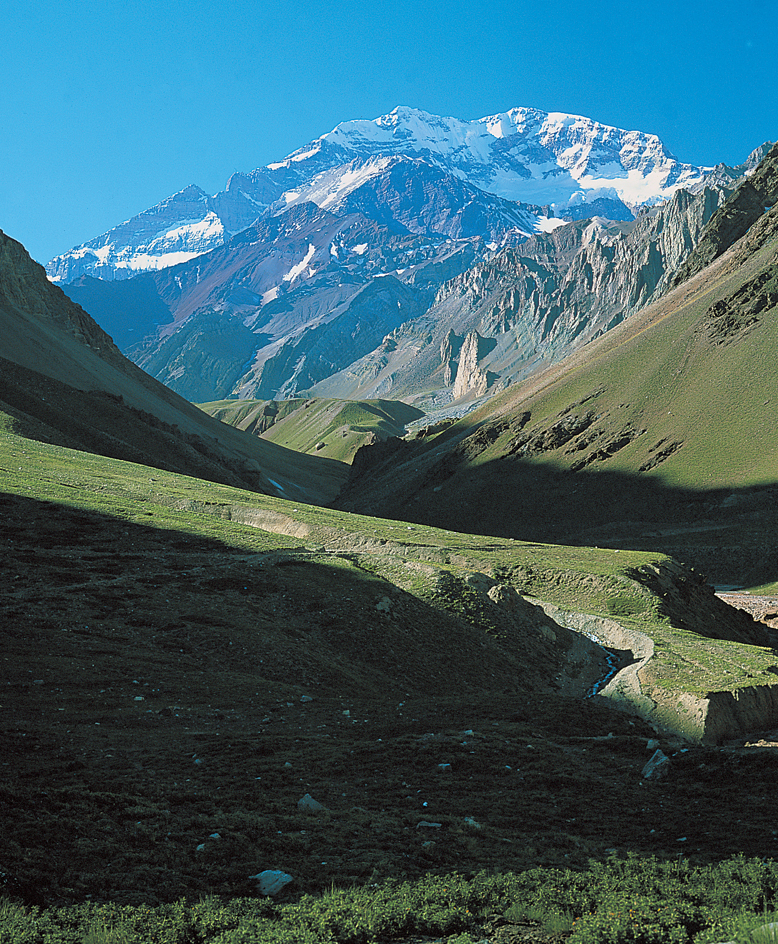
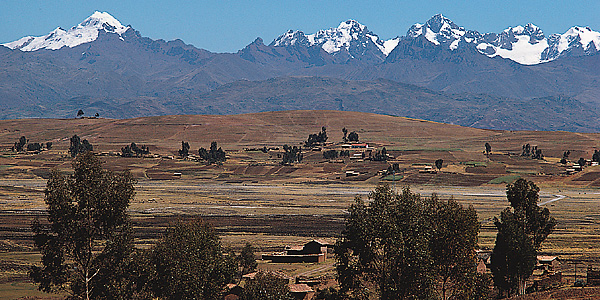
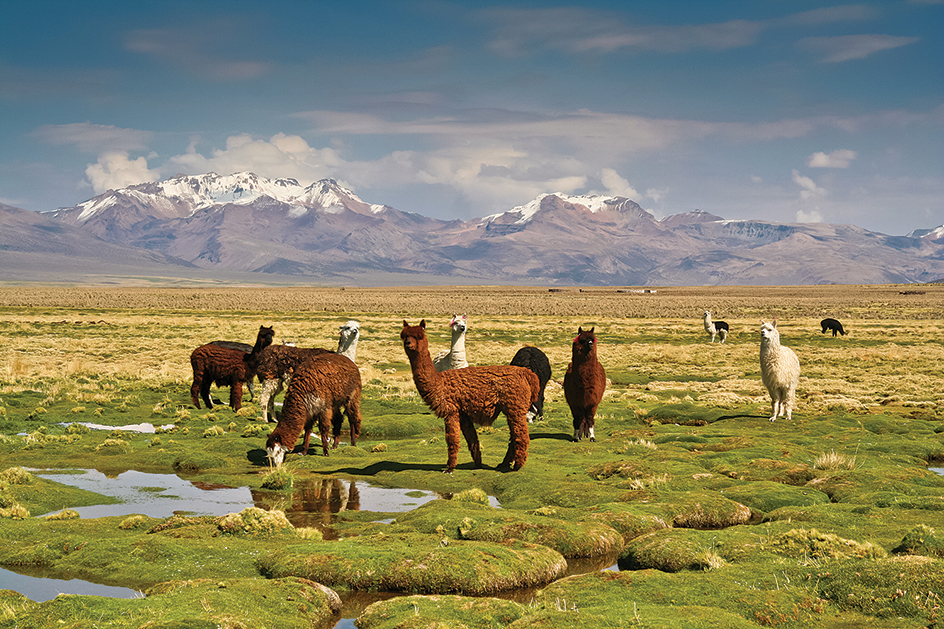
The activity of tectonic plates along the western coast of South America formed the Andes over the past 10 million to 15 million years. Tectonic plates are huge, rigid pieces of Earth’s rocky outer shell. Their movements and interactions continue to cause volcanic eruptions and earthquakes in the Andean region.
The Andes have great economic importance for several South American countries. The mountains contain large deposits of valuable minerals, including copper, gold, lead, tin, and zinc. Farmers cultivate coffee in the rich volcanic soils on the slopes of the Andes. In the high mountain valleys and plateaus, they grow thousands of distinct varieties of potatoes and such grains as barley, quinoa, rye, and wheat. Farmers also raise cattle and sheep for meat and wool.
At their widest point, the Andes divide into two mountain chains. Between these chains lies the Altiplano, a high plateau region that is cold, windswept, and nearly treeless. The Altiplano covers southeastern Peru, western Bolivia, northeastern Chile, and northwestern Argentina. It is a difficult region to farm because few crops grow well at such high elevations.
The Central Plains
extend eastward from the Andes, covering about three-fifths of South America. They are drained by huge river systems that empty into the Atlantic. Four large areas make up the Central Plains. One of these areas consists of rolling grasslands called the Llanos << YAH nohs >>, in the Orinoco River Basin of Colombia and Venezuela. These grassy plains with scattered trees provide grazing land for many large cattle ranches. Another area of the Central Plains is a lowland region called Selva, covered by tropical rain forest, in the Amazon River Basin of Bolivia, Brazil, and Peru. The third area, the Gran Chaco, consists of a hardwood scrub forest in north-central Argentina, western Paraguay, and southeastern Bolivia. The fourth area is the vast grassland of Argentina and Uruguay called the Pampas. Its fertile soil supports many farms and ranches. 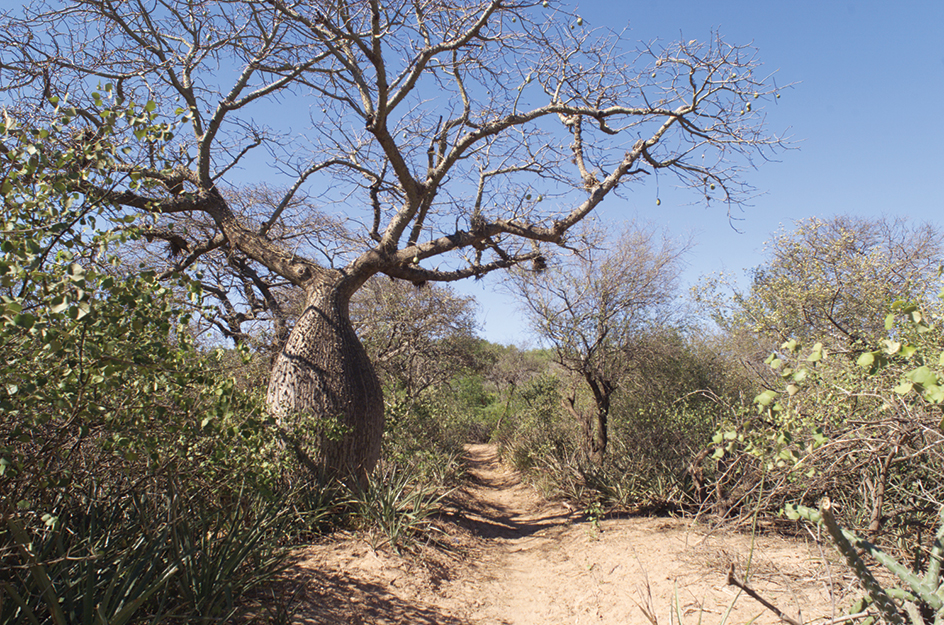
The Eastern Highlands
actually consist of two separate areas—the Guiana Highlands and the Brazilian Highlands. The broad Amazon River Basin separates the two areas. Mountains in the Eastern Highlands are much lower and older than the Andes.
The Guiana Highlands rise north of the Amazon basin. They lie about 3,000 to 5,000 feet (900 to 1,500 meters) above sea level. Tropical forests and open grasslands cover the region. The Guiana Highlands are thinly populated and largely undeveloped. 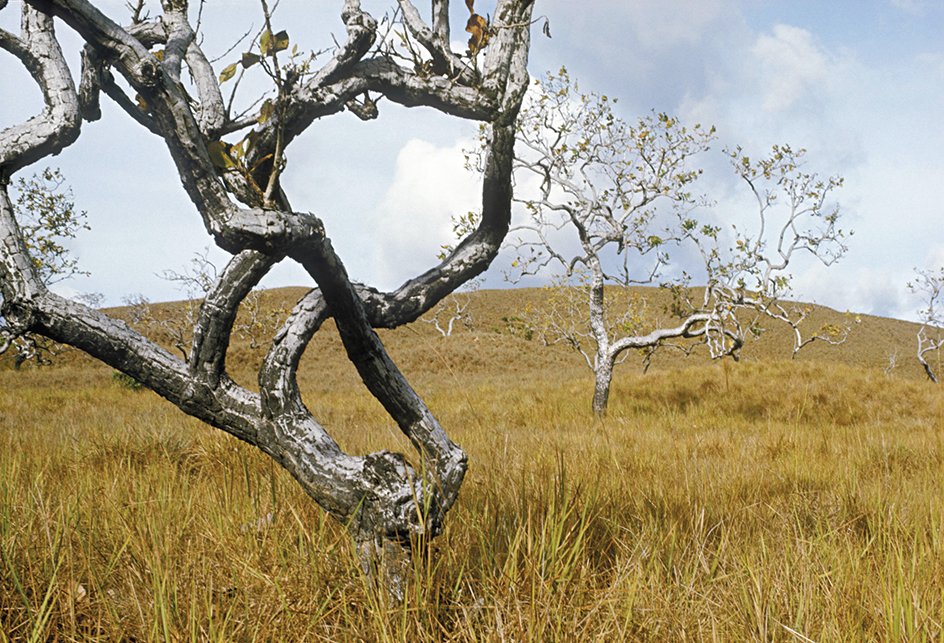
The Brazilian Highlands stretch south of the Amazon region to southeastern Brazil, covering nearly a fourth of the continent. The highest mountain in this region, Pico da Bandeira, rises 9,482 feet (2,890 meters) northeast of Rio de Janeiro. Most of the Brazilian Highlands, however, consist of rounded hills and flat tablelands between 1,000 and 3,000 feet (300 and 900 meters) above sea level. The southern Brazilian Highlands have fertile farms, fine cattle ranches, and rich mineral deposits.
Rivers.
Five large river systems drain most of South America. These river systems are: (1) the Amazon, (2) the Río de la Plata, (3) the Magdalena-Cauca, (4) the Orinoco, and (5) the São Francisco.
The Amazon River
system drains about 2,700,000 square miles (7,000,000 square kilometers) of land—the world’s largest drainage basin. The Amazon carries about one-fifth of the world’s fresh river water. It flows some 4,000 miles (6,437 kilometers) from the Peruvian Andes to the Atlantic. Only Africa’s Nile River is longer. Oceangoing ships can navigate the Amazon as far upstream as Iquitos, Peru.
The Río de la Plata
system is made up of the Paraná, Paraguay, and Uruguay rivers. It provides inland water routes for Argentina, Bolivia, Brazil, Paraguay, and Uruguay. The system empties into the Río de la Plata, a bay on the southeastern coast of South America. The Itaipú Dam power plant, built by Paraguay and Brazil on the Paraná River, is one of the world’s largest hydroelectric power projects. 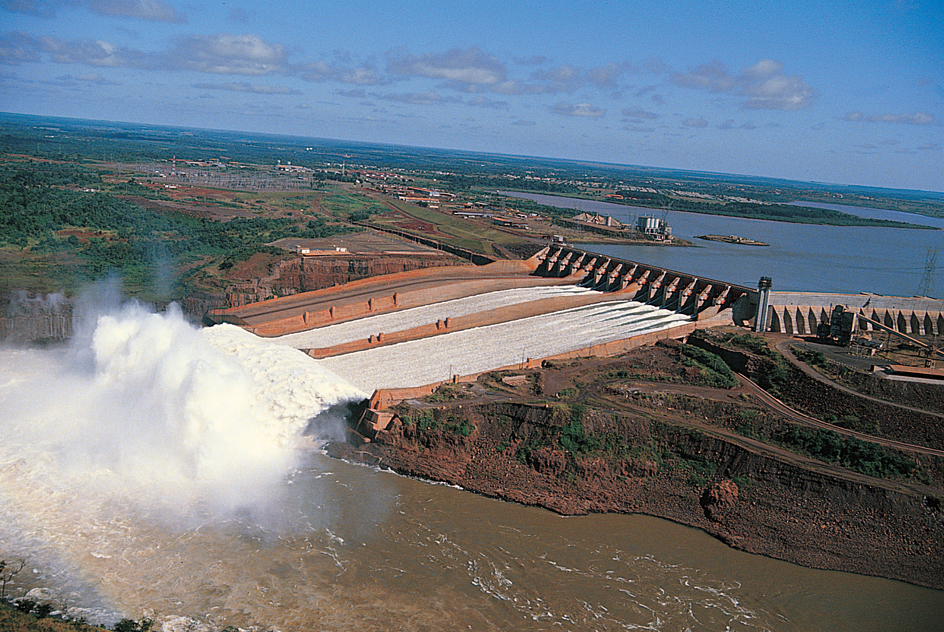
The Magdalena and Cauca rivers
rivers flow northward through two fertile farming valleys in Colombia. The Cauca River flows into the Magdalena, which empties into the Caribbean Sea.
The Orinoco River
runs in a broad arc through Venezuela to the Atlantic. For part of its length, the Orinoco forms the border between Colombia and Venezuela. The lower Orinoco crosses the Llanos, a productive ranching area in central Venezuela. Oceangoing ships travel up the Orinoco to load iron ore at the Venezuelan river port of Ciudad Guayana.
The São Francisco River
stretches for nearly 2,000 miles (3,200 kilometers) through northeastern Brazil. It flows northeastward through a large, drought-prone region and then turns toward the southeast and empties into the Atlantic. It is a broad, navigable waterway along about 900 miles (1,400 kilometers) of its middle course. Several large hydroelectric power plants generate electric power on the São Francisco.
Lakes.
South America has few large lakes. Lake Maracaibo in Venezuela is the continent’s largest. It covers 5,217 square miles (13,512 square kilometers). A short, narrow channel links Lake Maracaibo with the Gulf of Venezuela. Oil wells operate in the lake and along its shores.
Lake Titicaca, in the Andes, is the highest navigable lake in the world. It lies on the border between Bolivia and Peru at an elevation of 12,507 feet (3,812 meters). Crops that normally could not survive at such a high altitude grow in the area because the waters of Lake Titicaca warm the air. 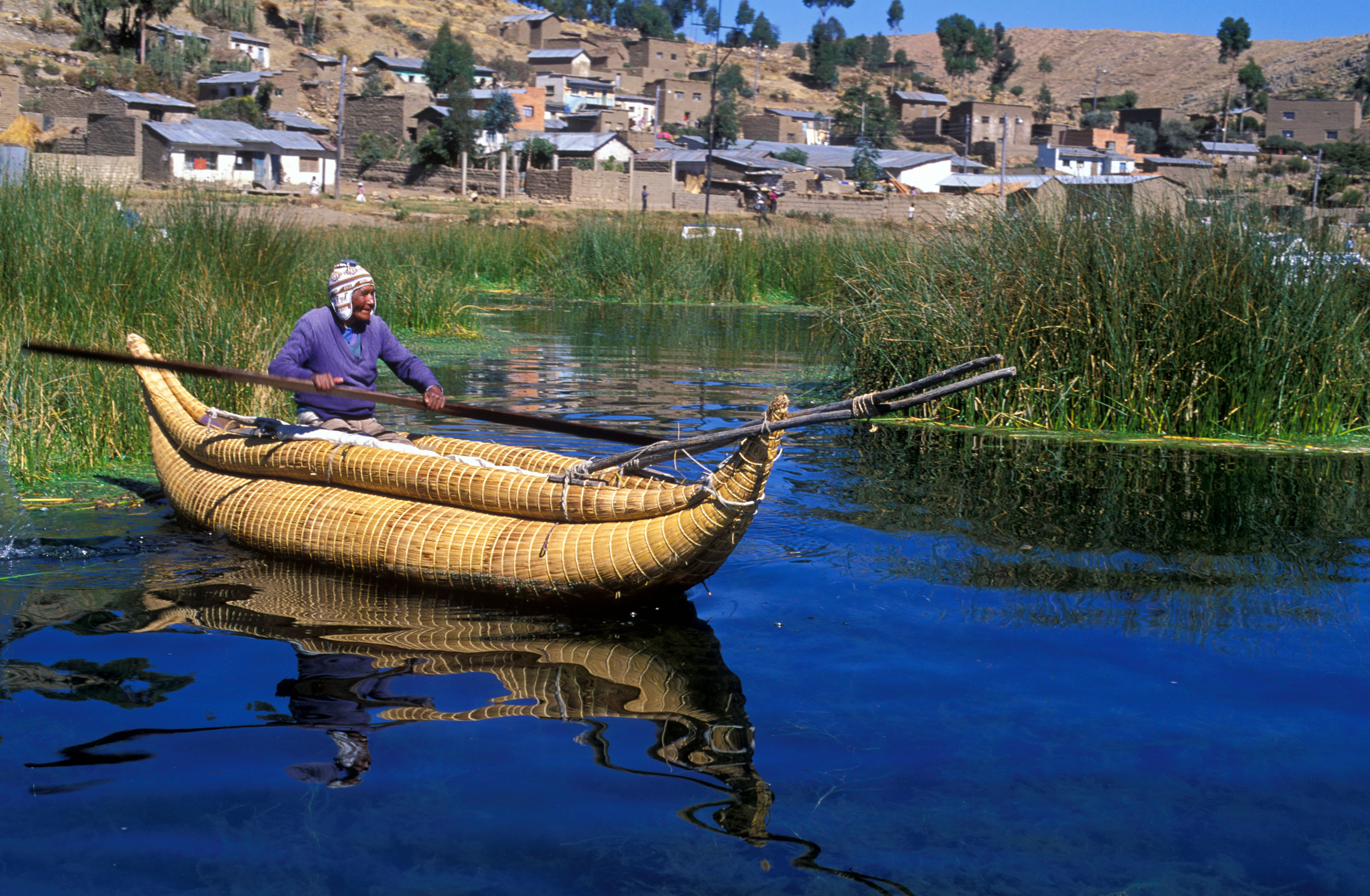
Waterfalls.
South America has many spectacular waterfalls. Angel Falls, in eastern Venezuela, has a longer drop than any other waterfall in the world. The water plunges 3,212 feet (979 meters) down a cliff, lands as a heavy mist, and drains into the Churún River. The world’s second highest waterfall, Cuquenán Falls, also lies in southeastern Venezuela. There, the Cuquenán River drops 2,000 feet (610 meters). 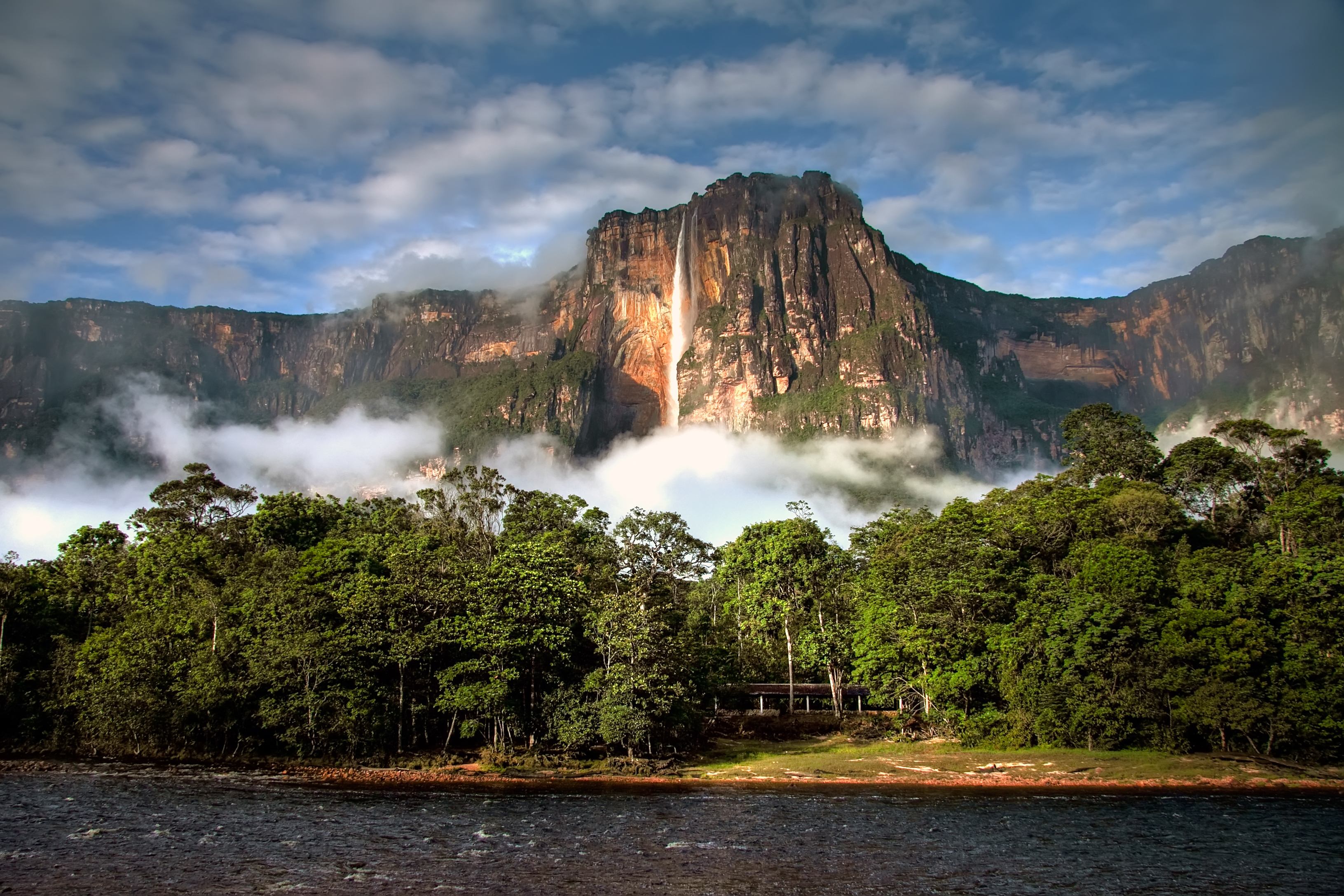
Iguaçu Falls (spelled Iguazu in Argentina) are on the border between Argentina and Brazil. Many people consider these falls the most magnificent natural sight in South America. The Iguaçu River forms Iguaçu Falls when it plunges 237 feet (72 meters) along an arc about 2 miles (3.2 kilometers) wide.
Tropical rain forests
cover more than a third of South America. Dense rain forests blanket most of the warm, wet Amazon River Basin and the northeast and northwest coasts of the continent. Many valuable forest products come from the lush Amazon region. 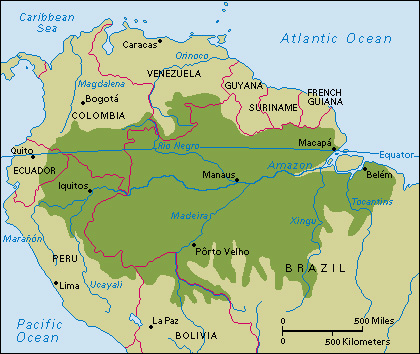
Large areas of coastal rain forest in Brazil have been cleared for farming and ranching. In such forests, most of the soil’s fertility comes from decaying leaves. As a result, the soil of the rain forest is thin and poor.
Deserts.
A coastal desert extends from southern Ecuador, along the coast of Peru, to meet the Atacama Desert of northern Chile. A much smaller desert covers the northern part of Colombia’s border with Venezuela. Patagonia, in southern Argentina, is a semidesert region. The Sertão of northeastern Brazil is a dry area covered with thorny bushes and low trees. Increasingly frequent droughts threaten to create a new desert there.
Coastline and islands.
South America’s long coastline has few natural harbors or bays. The best natural harbor is at Rio de Janeiro. Other bays include Todos os Santos Bay at Salvador, Brazil; the Gulf of Darién off Colombia’s Caribbean coast; the mouths of the Amazon and the Río de la Plata on the Atlantic; and Ecuador’s Gulf of Guayaquil on the Pacific.
South America includes several major island groups. The largest is the Tierra del Fuego group. These islands lie across the Strait of Magellan from the southernmost tip of the mainland. Argentina and Chile own them. Chile also owns the Juan Fernandez Islands in the Pacific, about 400 miles (640 kilometers) off Chile’s coast. The Falkland Islands, an overseas territory of the United Kingdom, lie in the South Atlantic about 320 miles (515 kilometers) east of the southern coast of Argentina. Argentina also claims these islands and calls them the Islas Malvinas. The Falklands and Tierra del Fuego have valuable sheep-grazing lands. The Galapagos Islands belong to Ecuador and lie in the Pacific about 600 miles (970 kilometers) off the coast of that country. They are the home of huge tortoises, sea turtles, and many other unusual animals. Marajo, an island at the mouth of the Amazon River, belongs to Brazil. Herders raise water buffaloes on this flat, grassy island.
Climate
South America has a wide variety of climates. They range from the dry desert conditions of northern Chile to the heavy rains along the windswept southwestern coast. Steamy heat characterizes the tropical rain forest of the Amazon basin, while icy cold air surrounds the lofty, snow-capped peaks of the Andes. In general, however, most of the continent has warm weather the year around. Only in the high Andes is it always cold.
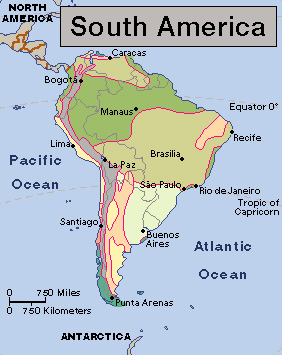
The hottest weather in South America occurs in Argentina’s Gran Chaco, where the temperature reaches 110 °F (43 °C). Temperatures in the Amazon region generally range from 70 to 90 °F (21 to 32 °C) and rarely reach 100 °F (38 °C). South of the equator, summer lasts from late December to late March, and winter runs from late June to late September. In the far south of Argentina, the temperature generally ranges from 40 °F (4 °C) in July to 60 °F (16 °C) in January, but it has dropped to as low as –27 °F (–33 °C).
Most of South America receives ample rain. Rainfall averages more than 80 inches (200 centimeters) a year in four areas: (1) coastal French Guiana, Guyana, and Suriname; (2) the Amazon River Basin; (3) southwestern Chile; and (4) the coasts of Colombia and northern Ecuador. Quibdo, Colombia, the rainiest place in South America, receives more than 350 inches (890 centimeters) of rain a year. Even the wettest regions of the continent generally have a dry season, however, when there is plenty of sunshine between downpours.
In southwestern Chile, humid westerly winds blow in from the Pacific and drop most of their moisture as rain before crossing the Andes. As a result, the area east of the Andes is dry. For example, the plateaus of Patagonia, in southeastern Argentina, receive only about 10 inches (25 centimeters) of rain a year.
Coastal Peru and northern Chile are among the driest places on Earth. Arica, the northern port city of Chile, receives an average of only 3/100 inch (0.76 millimeter) of rain a year. The dry conditions in this part of the continent result from the cold Peru Current, which flows northward from Antarctica and travels along the coast. This current cools the air. Because such cool air cannot hold much moisture, little rain falls in the region.
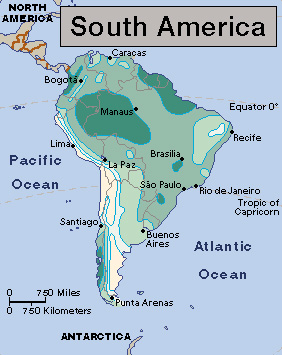
About every two to seven years, a pattern of interaction between Earth’s atmosphere and the tropical waters of the Pacific Ocean weakens the northward Peru Current and warm waters flow southward along the coast. This event is called El Niño (Spanish for the child). It usually occurs around Christmas, and its name refers to the Christ child. El Niño disrupts marine life, hurting the local fishing industry. It also produces torrential downpours in the usually dry region. See El Niño.
Animal and plant life
Animals.
South America has a great variety of animals, including about a fourth of all known kinds of mammals. However, it does not have such huge animals or such large herds of wild animals as are found in Africa. South America’s largest wild land animal is the hoglike tapir, which lives in the Amazon region and grows about as large as a pony. 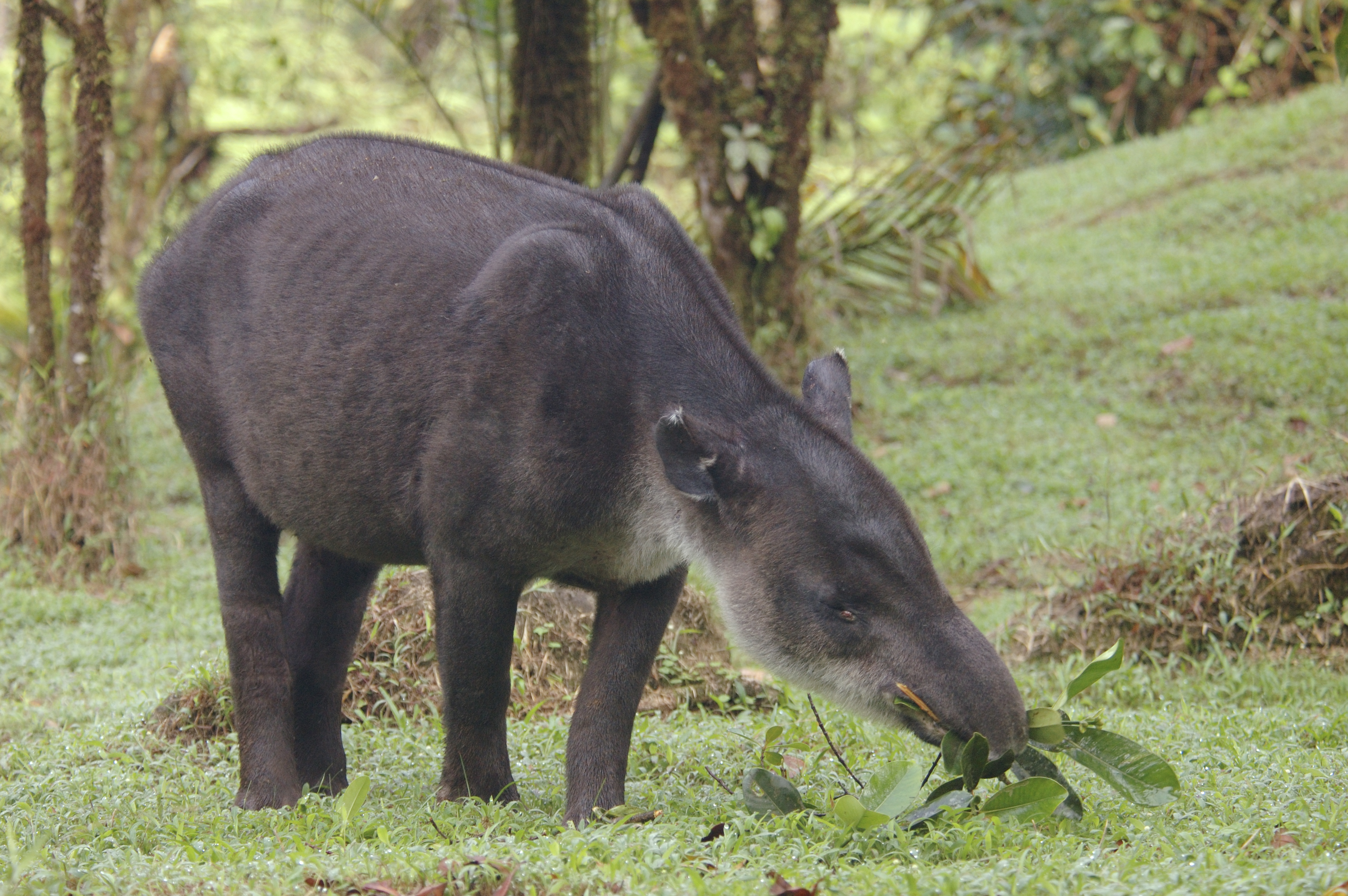
The Amazon River Basin has the greatest variety of animals on the continent. These include the capybara, the world’s largest rodent, which grows up to about 4 feet (1.2 meters) long. Trees in the rain forest provide homes for many kinds of monkeys. Other unusual forest dwellers include the armadillo, the giant anteater, and the sloth. The Amazon is also the home of the green anaconda, one of the world’s largest snakes. It may grow to about 30 feet (9 meters) long.
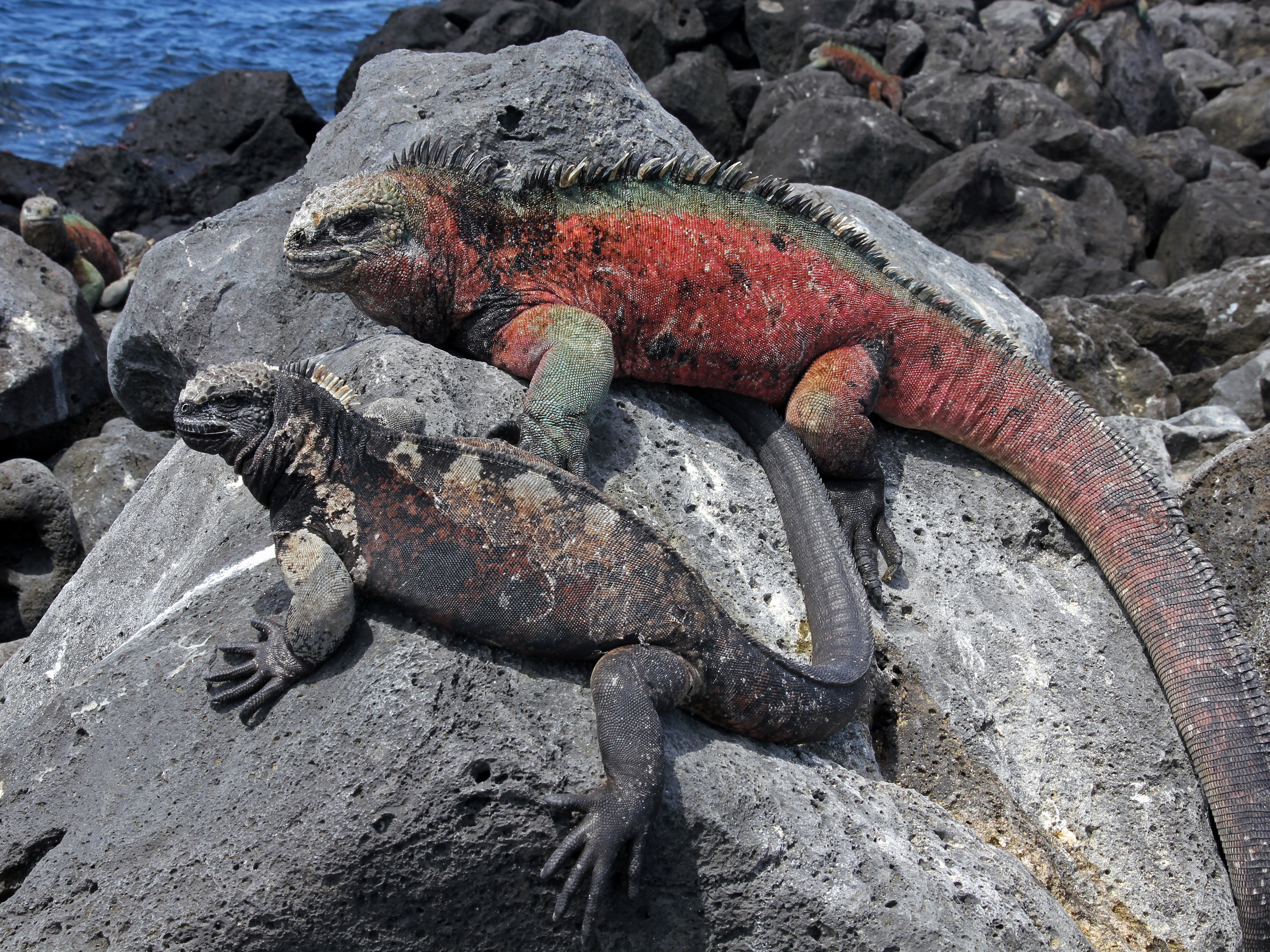
The manatee, a large water mammal, lives in the Amazon River. Amazon manatees weigh from 700 to 1,000 pounds (350 to 500 kilograms). Another large inhabitant of the river is the arapaima fish, which grows more than 7 feet (2.1 meters) long and commonly weighs more than 200 pounds (90 kilograms). Piranha also swim in the river. A school of these small fish may attack a much larger animal and devour its flesh, leaving only the bones.
Many kinds of birds live in South America. They include egrets, flamingos, hummingbirds, parrots, and toucans. The large, ostrichlike rhea lives in the Argentine Pampas. Ecuador’s Galapagos Islands support giant tortoises, sea turtles, crabs, iguanas, and a great variety of birds. Many of these animals are endemic species, meaning that they live nowhere else on Earth.
The vicuna and the guanaco, two wild members of the camel family, live high in the Andes. Scientists believe the alpaca and the llama, which were domesticated (tamed) in South America, may be descended from the guanaco. Alpacas produce fine wool. Llamas can carry loads of as much as 130 pounds (60 kilograms). The guinea pig also was domesticated in South America. 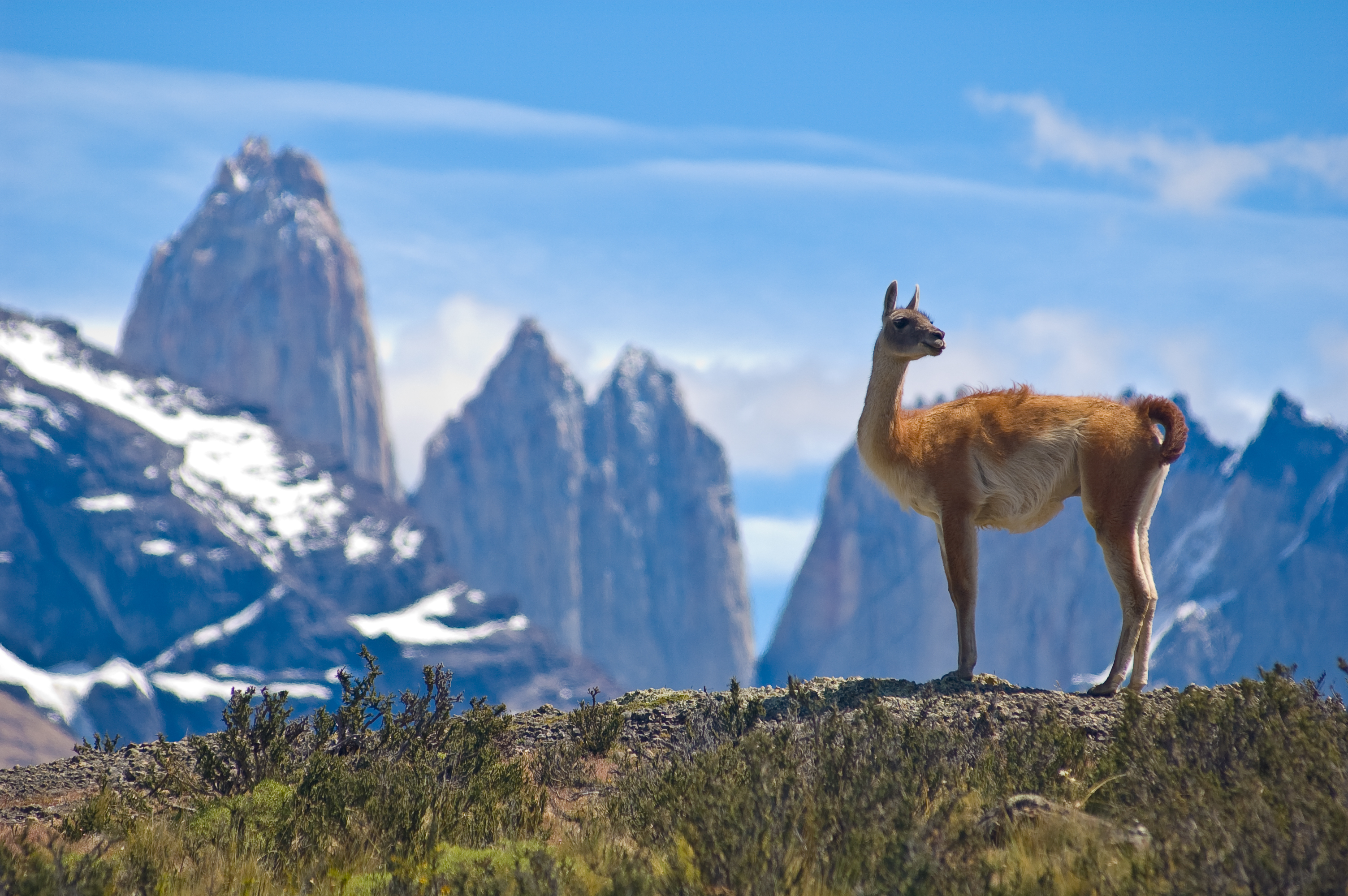
Plants.
South America has a great variety of plants, many of which grow on no other continent. The Amazon River Basin, sometimes referred to as “the green ocean,” contains tens of thousands of plant species. Countless kinds of orchids and about 16,000 types of trees grow in the Amazon rain forest. Many of the trees are hardwoods, including mahogany and rosewood, which are used in making fine furniture. The wood of some South American trees is so dense that it does not float. Other useful trees that grow in the Amazon River Basin include the rubber tree, the towering Brazil-nut tree, and the cacao tree, which produces beans used to make cocoa and chocolate. 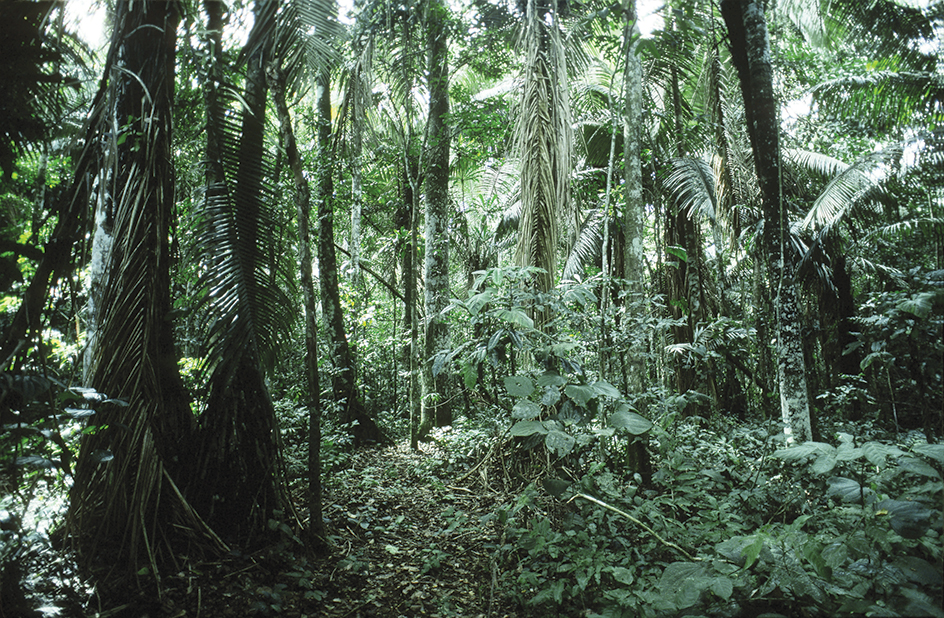
Many valuable plants live in other parts of South America as well. The sisal plant grows in dry northeastern Brazil. It produces fibers used in making twine. The pineapple plant also grows in this region, as does the carnauba palm, which produces lubricating and polishing waxes. Coca shrubs grow in the subtropical forests. Their leaves are the source both of illegal cocaine and of other, legal drugs used in medicine. Quinine, a drug used to treat malaria, comes from the cinchona tree found in Ecuador and Peru. Ecuador is the world’s largest producer of balsa, a lightweight wood. Tannin, a chemical used in tanning hides and making inks and dyes, comes from the quebracho tree of Argentina and Paraguay. The softwood of the Paraná pine of southern Brazil is used in the construction industry.
Several commercially valuable plants were brought to South America from other continents. These useful plants include bananas and coffee—two of South America’s most important export crops. In the mid-1800’s, people brought the eucalyptus tree from Australia to South America. It has become common over much of the continent and is a valuable source of firewood.
Economy
South America has abundant natural resources. These include vast stretches of fertile land; raw materials, such as hardwoods and minerals, used in manufacturing; and plentiful energy resources, such as natural gas and petroleum. However, many of these resources remain undeveloped.

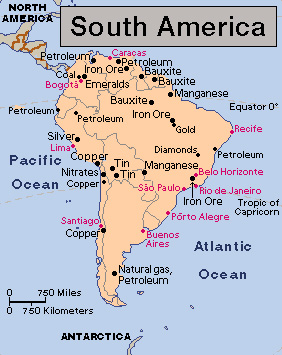
All the countries of South America have developing economies. Argentina, Brazil, Chile, Colombia, and Uruguay have the most developed economies, which include successful modern manufacturing industries. Other nations have smaller manufacturing sectors and rely upon a narrow range of agricultural and mineral exports for income. They purchase manufactured goods from overseas. Some also import food and energy resources. Bolivia and Paraguay are among the least developed nations on the continent.
In general, the countries of South America have a lower gross national product (GNP)—the value of all goods and services produced in a country in a year—than do North American and European countries. The per capita GNP—the GDP divided by the total population—is an indication of a country’s standard of living. In the late 2010’s, the average annual per capita GDP in South America was about $15,000. In comparison, the annual per capita GDP of the United States was about $60,000. In all of South America’s countries, wealth is unevenly distributed. A few people earn far more than the per capita average, but a great majority of the people earn far less.
Agriculture.
About four-fifths of South America’s land could be used for agriculture. However, only about one-third is used for agriculture, and most of that serves as pasture for grazing animals. Most land in South America is divided into large properties called latifundios, which are owned by a small percentage of the population. Latifundios include haciendas (large farms or country estates); plantations, often owned by foreign companies; and technologically sophisticated farms controlled by agribusinesses (companies that produce, transport, distribute, and sell farm products).
Small properties called minifundios greatly outnumber the latifundios. Minifundios generally provide a single family with food. They often employ traditional farming methods that rely upon human and animal labor. Minifundios cover much less of South America’s good farmland than latifundios do. 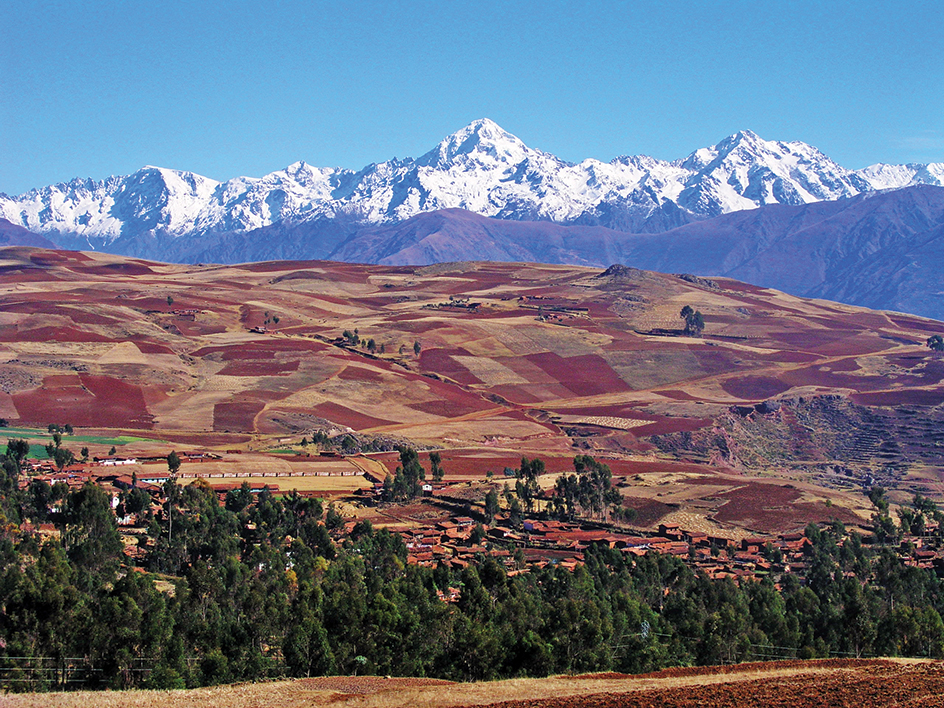
Millions of rural South Americans do not own any land. They work for wages on the latifundios or as sharecroppers, receiving a percentage of the crops they raise as payment. Since the mid-1900’s, many rural South Americans have moved to cities in search of better job opportunities. By the late 2010’s, only about 15 percent of the continent’s population lived in rural areas.
During the colonial period, which lasted from the 1500’s to the 1800’s in South America, farmers grew crops primarily for foreign markets. Each country produced just a few crops, such as cacao, coffee, cotton, and sugar. The invention of refrigerated shipping in the late 1800’s made it possible to transport such perishable goods as fruits and meats over long distances.
Today, Ecuador exports more bananas than any other country in the world, and Colombia is a leading exporter. Argentina, Brazil, and Colombia produce beef for European markets. Brazil and Colombia are among the world’s leading exporters of coffee. Wheat and corn are the chief grains produced for consumption in South America. Farmers also cultivate potatoes and rice for domestic markets. 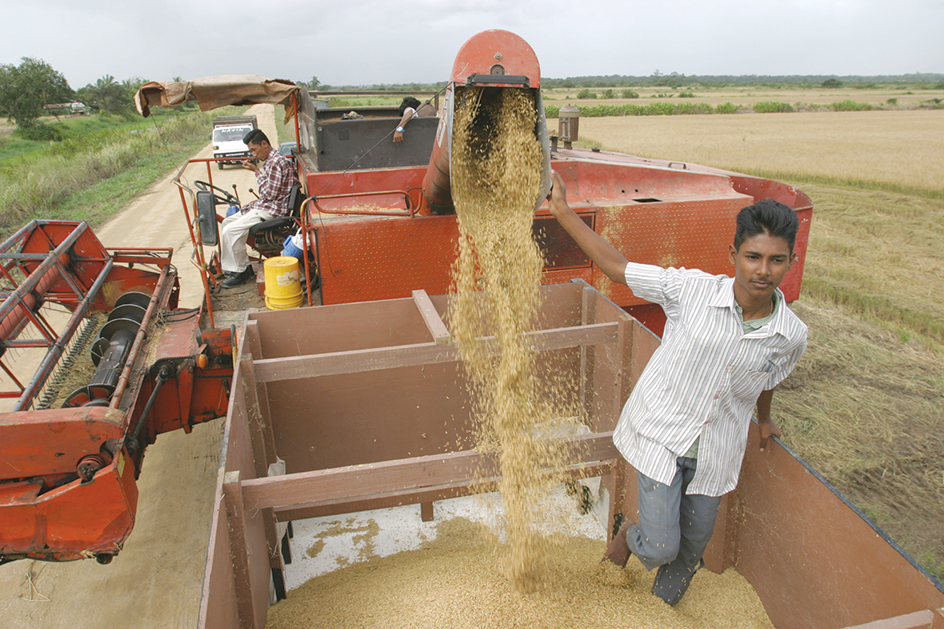
Since the late 1900’s, many farmers have begun growing nontraditional crops. Several countries, including Colombia, cultivate flowers for sale in North America and Europe. Some countries produce fruits and vegetables for export during the winter months in the Northern Hemisphere. Argentina and Chile produce wine grapes, while soybeans for animal feed are a chief export of Argentina and Brazil.
Many farmers earn high profits cultivating such illegal crops as coca, used to produce cocaine; poppies, used to make heroin; and marijuana. Efforts to encourage growers to substitute legal crops for illegal ones often fail because the illegal crops earn high profits.
Manufacturing.
Until the 1800’s, Spain and Portugal hindered the development of manufacturing in South America, preferring instead to export the continent’s raw materials. During the 1800’s and early 1900’s, newly independent countries continued this practice. At the same time, such nations as the United Kingdom and the United States discouraged the development of South American industry. In doing so, they hoped to limit local competition with their own manufactured goods. It was not until the 1930’s and 1940’s that the countries of South America began manufacturing goods for domestic use and for export to North America and Europe. Argentina, Brazil, and Chile emerged as the most heavily industrialized nations in South America.
In the early and mid-1900’s, South American governments closely controlled their national economies. They often owned manufacturing firms, as well as airlines, banks, and utility companies. Governments tried to protect their industries from foreign competition by imposing tariffs (taxes) on imports and giving subsidies (aid payments) to domestic firms. They had to take out loans to pay these subsidies. In the 1980’s, many countries could not repay their loans, which led to a debt crisis. Following the crisis, nations began to privatize their industries. Privatization involves the sale of government-owned industries or portions of them to private, often foreign, companies.
Today, governments encourage the manufacture of goods for export, and South America makes a greater variety of products than ever before. Brazil, one of the world’s leading industrial countries, produces airplanes, automobiles, and electronics. São Paulo, Brazil, is South America’s chief manufacturing center. In most other South American nations, manufacturing includes such consumer goods as beverages, furniture, processed foods, shoes, and textiles.
Several countries have created export processing zones where foreign-owned factories operate. These factories employ many South Americans. The multinational firms that own them benefit from favorable taxation policies and lower labor costs.
Mining.
The mountains of South America have long been a source of mineral wealth. Deposits of gold and silver attracted the Spanish and Portuguese to the area in colonial times. Today, the Amazon River Basin is another significant source of mineral wealth.
South America’s mineral resources are distributed unevenly. Paraguay possesses few useful minerals. Brazil is a leading producer of iron ore and manganese. Brazil and Guyana are among world leaders in mining bauxite, used to make aluminum. Chile is a major source of copper, mined in the Atacama Desert. Peru has copper deposits and exports zinc as well. Colombia is a leading source of emeralds, and Amazonian gold is emerging as a significant export. 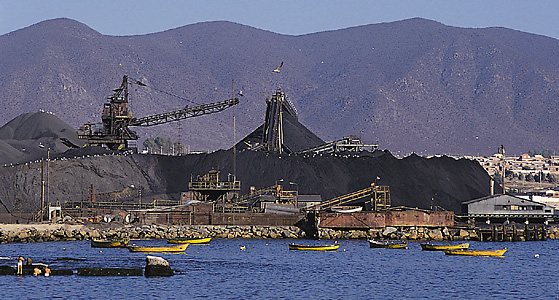
Global demand for the continent’s energy resources, particularly oil and natural gas, has increased since the late 1900’s. Brazil, Colombia, Ecuador, and Venezuela export oil. Bolivia and Peru export large quantities of natural gas. 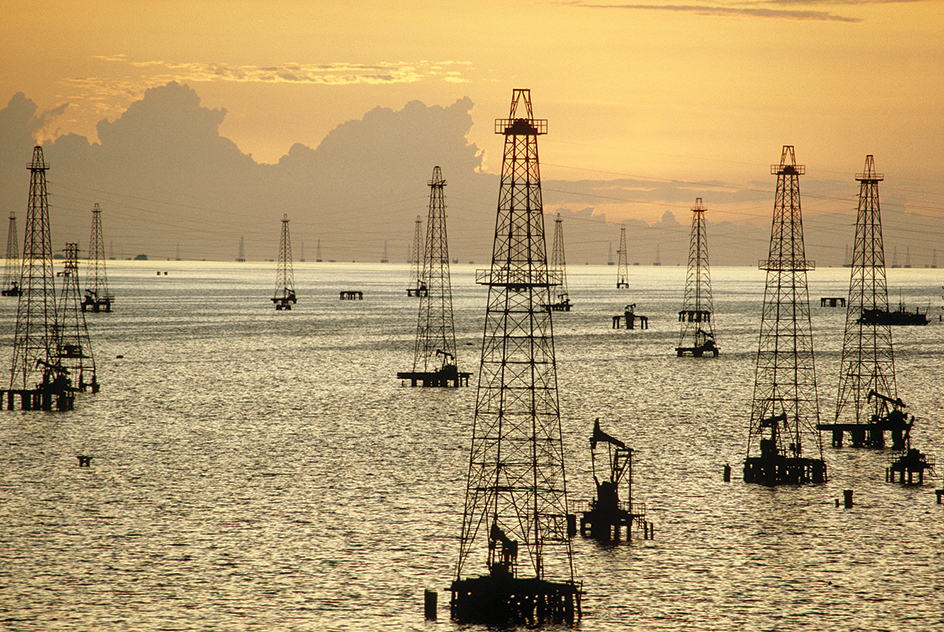
Mining in South America generates great wealth for a small portion of the population and for large corporations. Because mining is highly mechanized, it creates only a few jobs. It does, however, cause substantial environmental damage. For example, mercury and other toxins used to process mineral ores pollute South America’s water.
Forestry and fishing.
Brazil is South America’s chief producer of forestry products. All the countries in the Amazon River Basin have forestry industries that produce such hardwoods as greenheart, mahogany, and rosewood. Builders use the extremely dense greenheart, found in the Guiana Highlands, to construct ships and piers. Softwood pine trees grow in southern South America.
South American forests yield many products besides wood. These include coconuts, dates, edible nuts, oils, and ingredients used to make medicines and other pharmaceutical products. The sap of rubber trees, which grow naturally in the Amazon rain forest, is used to make rubber tires. This sap is called latex.
During the debt crisis of the late 1900’s, many countries leased land to foreign logging firms that cut down vast areas of trees. Large-scale logging caused such environmental problems as soil erosion, water pollution, and the extinction of some species of animals, plants, and microbes. Since then, many South American countries have begun to plant trees in afforestation and reforestation programs.
Chile and Peru have South America’s most valuable fishing industries. The cool Peru Current (also called the Humboldt Current), which flows along South America’s west coast, is rich in plankton and other small organisms that many fish eat. The anchoveta, a fish used to make oil and animal feed, is one important commercial variety. Both freshwater and ocean fish provide protein in the diets of many South Americans. But decades of overfishing have reduced fish stocks worldwide and caused a decline in South America’s fishing industry since the late 1900’s.
Service industries
employ more than half of South America’s work force. They include banking, commercial sales, government services, health care, and tourism. Many service jobs, such as cleaning and food preparation, require few skills and pay low wages. Such industries as data processing, legal services, and telecommunications, which require high levels of education, are becoming increasingly important.
South American cities are home to many underemployed people who lack full-time jobs. They often work in the informal economy that exists outside of government control and taxation structures. The informal economy provides low-cost services to many South American professional people, who earn less than their counterparts in North America and Europe. The informal economy also includes such illegal activities as prostitution (the performance of sexual acts for payment) and the sale of illegal drugs.
International trade.
The countries of North America and Europe have long ranked as South America’s leading trading partners. International trade between South American countries is also important. In addition, Middle Eastern countries buy many South American products. Trade with such Pacific nations as Australia, China, Japan, and South Korea has increased since the late 1900’s, as the economies of those countries have grown stronger. Major exports of South America include agricultural, forest, and mineral products. Some major imports are chemicals, foodstuffs, fuels, machinery, and transportation equipment.
All the countries of South America are members of the World Trade Organization (WTO), which sets rules for international trade and works to reduce trade barriers between countries. In 1991, Argentina, Brazil, Paraguay, and Uruguay formed a trade association called Mercosur. Mercosur strives to increase trade among members and promotes closer commercial ties with the European Union. The Andean Community, another trade association, was founded in 1969. Its members are Bolivia, Colombia, Ecuador, and Peru. The Andean Community has had less success increasing trade among members because several of its members produce similar goods.
Transportation.
The geography of South America presents many obstacles to transportation. Rugged mountains, dense rain forests, and harsh deserts make it difficult to construct efficient transportation systems. The continent lacks extensive rail lines. Those railroads that do exist are aging lines in need of modernization. For this reason, ships carry most of South America’s imports and exports. Cargo and passenger boats travel up and down the Amazon River. Chile uses ferries to link its central region to the far south, where the irregular coastline has no paved roads. 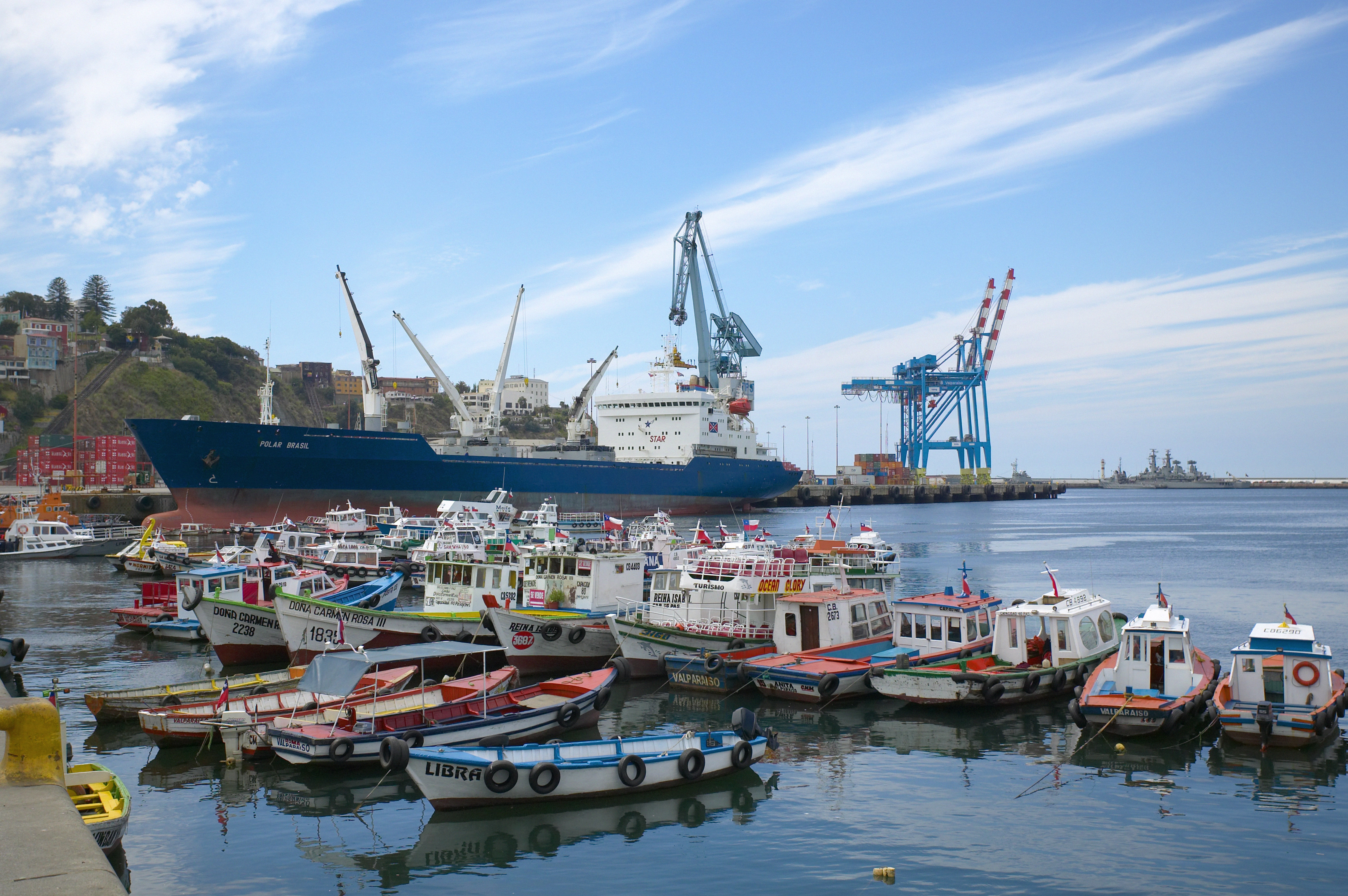
Airlines provide passenger service within and between countries and transport some cargo. Most South Americans cannot afford to fly, nor do they own automobiles. For them, buses offer a cheap alternative. Buses travel extensively throughout the continent, on mountain roads as well as on highways. They are also the primary means of transportation in urban areas. Long-distance buses in Argentina, Brazil, Chile, and Peru are quite comfortable. The number of automobiles in South America is increasing, and traffic congestion and air pollution are problems in large cities. Subway systems operate in a few major cities.
Increased trade between South American nations has made it necessary to improve transportation within the continent. Countries have begun to cooperate to integrate their transportation systems and build roads to carry goods across borders and to the coast. In 2003, a huge port facility called a megaport began operations on Chile’s northern coast at Mejillones. The megaport provides several countries with access to the Pacific Ocean. 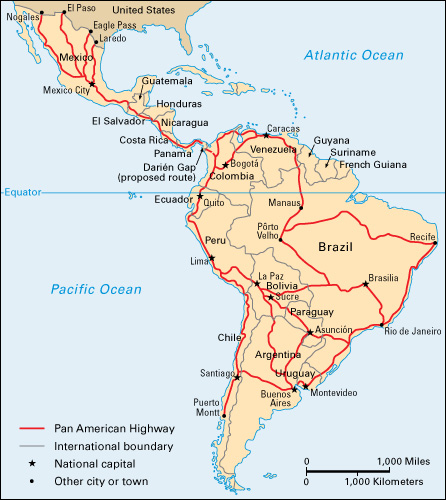
Communication.
Books, magazines, and newspapers are important means of communication in South America. In most countries, at least 90 percent of adults can read and write. Radio and television are other major means of communication.
Television has grown in significance, especially in urban areas, where it is common even in poor neighborhoods. In 2005, Venezuela launched Telesur, a TV network that broadcasts news from a Latin American point of view. Argentina, Bolivia, Cuba, Ecuador, Nicaragua, and Uruguay also own shares of Telesur. Soccer matches and soap operas called telenovelas are the most popular television programs in South America.
Telephone service extends to all but the most remote communities in South America. A growing number of people use cellular phones to do their daily business. Since the mid-1990’s, use of the Internet has grown a great deal.
